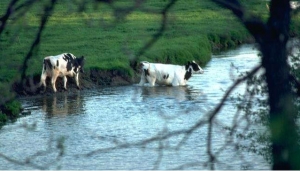Water for Dairy cattle
Dietary Phosphorus and Water Quality

There is a direct relationship between phosphorus (P) levels in dairy cattle rations and the amount of phosphorus excreted in manure. The phosphorus content of manure varies significantly with the diet and depends on the level of P and ingredient composition of the diet. Approximately 80% of consumed phosphorus is excreted when fed in excess. While some of the P excreted is truly indigestible feed P (45-60%), a large proportion of excess P is excreted.
Phosphorus Requirements
Cattle require P in their diet for basic maintenance of the body, including bone formation, building muscle tissue, and milk secretion. The National Research Council's dietary phosphorus requirement ranges from about .33% - .45% of dry matter intake (DMI). Phosphorus percentage needed increases with level of milk production. Levels above .40% generally are only needed when feed intake is unusually low relative to milk yield.
| Dietary P content needed by a 1320 lb cow with varying milk yield and DMI | |||||
| Milk yield, lbs/d | DMI, lbs/d | % P needed in diet | |||
| 66 | 42 | 0.40 | |||
| 46 | 0.37 | ||||
| 50 | 0.34 | ||||
| 88 | 50 | 0.42 | |||
| 54 | 0.39 | ||||
| 58 | 0.37 | ||||
| 110 | 58 | 0.44 | |||
| 62 | 0.41 | ||||
| 66 | 0.39 | ||||
Do cows really need high phosphorus levels in the diet to sustain healthy reproductive cycles?
The common perception among dairy producers, nutritionists, and veterinarians is that higher levels of dietary P, that is higher than National Research Council (NRC) guidelines, improves reproduction. Underfeeding P (dietary levels of .20 to .25%) is known to impair reproductive performance; however, years of research indicate that there is no benefit to feeding P greater than NRC recommendations. A University of Wisconsin study compared two different phosphorus levels in rations over two years.
- The rations contained either .35% P or .45% P.
- Total lactation milk yield, days to first estrus, days open, pregnancy rate, and services per conception were not different for these dietary P levels.
- These scientists concluded that the current NRC requirement of .40-.45% P may be too high. They concluded that levels above NRC are unnecessary and costly to the environment.
Why is over-application of phosphorus to cropland of concern?
Unlike nitrogen, phosphorus fixed in the soil is relatively stable and doesn't leach to ground water. Instead, it accumulates in soil. Scientists have found that with very high soil test P, P can run off even without erosion. But the P leaving farms, either bound to soil or dissolved in water, accumulates in surface water and can pollute ponds, streams, and lakes. Like excess nitrogen, excess phosphorus causes algae populations to grow or to "bloom" in the water. Increased algae populations consume oxygen in water, the same oxygen which fish need to survive. The absence of oxygen in water causes fish to die.
| What's the phosphorus content of common feedstuffs? | |||||
|
Forages
|
P, % of DM | Concentrates | P, % of DM | ||
|
Alfalfa hay, early bloom
|
0.22 | Barley grain | 0.38 | ||
|
Alfalfa silage, early bloom
|
0.31 |
Brewers grains
|
0.57 | ||
|
Barley silage
|
0.28 |
Corn grain
|
0.27 | ||
|
Corn silage
|
0.22 |
Ear corn
|
0.29 | ||
|
Orchardgrass, early bloom
|
0.32 |
Cottonseed, whole
|
0.62 | ||
|
Rye silage
|
0.32 |
Cottonseed meal, 41% CP
|
1.16 | ||
|
Sorghum sudan silage
|
0.21 |
Distillers grains
|
0.43 | ||
|
Peanut meal
|
0.66 | ||||
|
Wheat grain
|
0.43 | ||||
|
Wheat midds
|
1.0 | ||||
|
Fishmeal
|
3.14 | ||||
|
Soybean meal
|
0.71 | ||||
|
Wheat bran
|
0.71 | ||||
What can you do?
Phosphorus excretion in manure can be reduced if the content of P in diets is reduced to meet, but not exceed, the cows true requirements, using NRC guidelines. A Virginia Tech survey of 33 Virginia dairy farms found that P losses could be reduced by 45% or more if rations were formulated according to current published NRC requirements.
In the 33 herds surveyed, the average P content of the total ration was 0.49%. The P content recommended by NRC ranged averaged 0.34%. Survey farms could decrease their feed bill by $800 to $1,050/year by feeding P at actual NRC requirements compared to current feeding levels. Those farms feeding diets with .55% P had increased feed costs of $1,460 to $1,570/year.
Decreasing dietary P from our survey average of .49% to the required .34% level decreased acreage requirements for manure disposal by 71%.
Summary
When phosphorus is overfed, P excretion is increased with no beneficial impact on milk yield or reproduction. Reduced overfeeding of P reduces feed costs substantially.
If P based nutrient management becomes the law, reduced overfeeding of P will reduce land acreage required to dispose of manure.






















